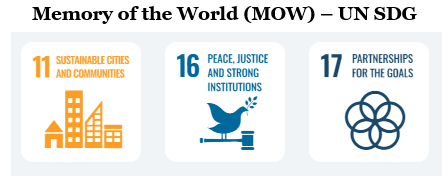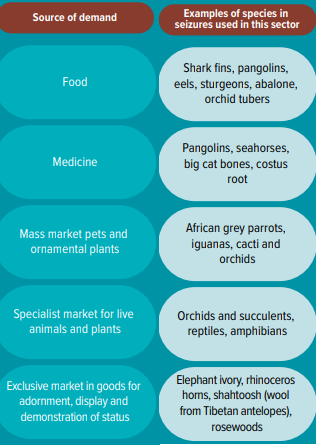Giant Shrike
Giant Shrike was spotted near the road to Bum La pass and Sangetsar Lake in Arunachal Pradesh, first sighting in India.
- Scientific name – Lanius giganteus
- Habitat – Found at high elevations, in open habitats with stunted shrubs such as rhododendron.
- Descends to lower elevations during the winter.
- Distribution – It is a species endemic to much of Indian sub-continent and has been previously observed in China, Tibet and Bhutan as well.
- Features – A large and long-tailed shrike with dark gray upperparts, white underparts, a black mask, and white in the wing.
- The white patches in the black wings and tail are especially conspicuous in flight.
- Vocalizations include harsh rasping notes and more musical, liquid ones.
Giant Shrike is similar to Chinese Gray Shrike, but larger, with a darker gray back and no white eyebrow.

References
- The Indian Express| Giant Shrike spotted in Arunachal Pradesh
- eBird| Features of Giant Shrike
Memory of the World Asia-Pacific Regional Register
Memory of the World (MOW) Regional Register inscribes 20 new items in recognition of human innovation and imagination in Asia-Pacific.
|
Memory of the World (MOW)
|
- Launched by - United Nations Educational, Scientific and Cultural Organization (UNESCO), in 1995
- Objectives – Facilitate preservation of the world's documentary heritage, particularly in areas affected by conflict and/or natural disaster.
- Enable universal access to documentary heritage worldwide.
- Enhance public awareness about the significant of documentary heritage among the wider public.
- Total inclusion – 496

|
- MOWCAP – The Memory of the World Asia-Pacific Committee.
- MOWCAP Regional Register – A listing of those “documentary heritage of influence” in the Asia/Pacific region approved for inclusion by MOWCAP.
- Successful nominations to MOWCAP are entered on the Asia/Pacific Regional Register.
- Call for nominations and inscriptions – It is made every 2 years unless unexpected circumstances make this impractical.
- Nominations will normally be called for in the even-number years (to alternate with the International Register).
- Approval – After recommendations from the Register Subcommittee (RSC), and voting by member state representatives.
- UllanBatar convention – General meeting of MOWCAP held in Ulaanbaatar, Mongolia in 2024, which celebrates Asia-Pacific achievements in geneology, literature, and science, among others.
- It saw the inclusions from Australia & Tuvalu – Funafuti, Indonesia, India, China, Bangladesh, Malaysia, Mongolia, Philippines, Vietnam and Uzbekisthan.
- India’s 3 items in MOW
- The Illustrated Manuscripts of Rāmacaritamānasa of Tulasīdāsa
- The Manuscript of the Sahṛdayāloka-Locana: Seminal Text of Indian Poetics, authored by Acharya Anandvardhan.
- The 15th Century Manuscript of the Pañcatantra Fables - authored by Acharya Anandvardhan, Pt. Vishnu Sharma
The Indira Gandhi National Centre for the Arts (IGNCA) advocated for 3 Indian nominations in Memory of the World Asia-Pacific Regional Register at the 10th General meeting of MOWCAP held in 2024.
- Significance to India – It is the 1st time IGNCA has submitted nominations to the Regional Register since its inception in 2008.
References
- PIB| 3 Indian items in MOW Asia-Pacific Register
- UNESCO| The Memory of the World
- UNESCO| Memory of the World Regional Register- Asia Pacific
History Sheet
The Supreme Court has asked all states and Union Territories to ensure ‘history sheets’ drawn up by their police do not reflect caste prejudices.
- A history sheeter – In police parlance and procedure, the person is an individual with a significant criminal history, someone who has been implicated in multiple offences (more than 2 cases).
- Process of opening history sheet – It is governed by the police rules of respective states.
- For example: Punjab Police Rules, 1934 is applicable in Punjab, Haryana, Himachal Pradesh, Delhi, and Chandigarh.
- It begins automatically when the Station House Officer (SHO), who is the head of the police station, takes notice of individual
- For conviction for dacoity, robbery, burglary, and theft
- For habitual offenders; and upon release from life imprisonment for certain cases of financial crime.
The term history sheet appeared for the 1st time in the Punjab Police Rules of 1934.
- History sheet – It contain a description, with special attention to peculiarities of appearance, relations & other connections of the individuals connected with criminal activities.
- Moreover, any property owned the criminal, and her mode of earning a livelihood, should also be entered.
In 2024, the Delhi Police Commissioner had issued a Standing Order saying details of minor relatives should not be included in the history sheet.
- Different kinds – Known Depredators sheets, suspect sheets, rowdy sheets, members of organised crime sheets, and budding criminal sheets, all depend on the assessment of the police.
- Report submitted to – The Superintendent of Police (SP) of the district through the Assistant Commissioner of Police (ACP).

- Challenges – A 2010 research paper from National School of Law noted that the language used in police rules is “similar to police records of ‘criminal tribes’ in colonial India”.
The Criminal Tribes Act, 1871 stated that if the local government had reasons to believe that any “tribe, gang or class of persons” is addicted to the commit non-bailable offences, the government may report the case and request to get the tribe or gang to be declared “criminal”.
Reference
The Indian Express| SC warns to avoid caste prejudices in history sheets
FLiRT
Cases of FLiRT COVID variants which are currently spreading faster in the US have been recorded in India.
- KP.2 – A subset of COVID variants, nicknamed “FLiRT,” drawn from the letters in the names of their mutations.
- Direct descendant of JN.1 – KP.2 has 3 substitutions in the S protein and additional 1 substitution in non-S protein.
- This might make it better at evading our immune defenses and slightly more infectious than JN.1.
KP.2 is taking off, which made up just 1% of cases in the US in mid-March in 2024, now makes up more than 25%. While KP.2 is circulating faster, the other FLiRT variant, KP.1.1 variant is not widespread yet.
- Infection – There are possibility of getting reinfected with KP.2 even if one had been infected earlier with JN.1, particularly if it’s been several months or longer since your last bout of COVID.
- KP.2 could infect even people who got the most updated vaccine.
- Virulence – There isn’t enough evidence yet that KP.2 would cause more severe illness than other strains.
- But people who are age 65 and older, pregnant or immunocompromised remain at higher risk of serious complications.
- Symptoms – Mostly similar to those seen with other variants that include sore throat, runny nose, coughing, head and body aches, fever, congestion, fatigue and, in severe cases, shortness of breath.
- Many individuals might also have symptoms like diarrhea, nausea and vomiting.
- In India – As per reports, 91 cases of the new Covid-19 Omicron subvariant KP.2 has been recorded in Maharashtra.
References
- The Indian Express| FLiRT
- Times of India| FLiRT variant in India
World Wildlife Crime Report, 2024 (WWCR3)
The 3rd edition of the World Wildlife Crime Report probes recent trends in the illicit trafficking of protected species of wild fauna and flora.
- Tagline – Trafficking in Protected Species
- Published by – United Nations Office on Drugs and Crime (UNODC), every 4 years.
The 2 previous editions were published in 2016 and 2020 respectively.
- Aim – To provide a tool to assess and improve responses to wildlife trafficking.
- Data sources – CITES Annual Illegal Trade Reports, supplementary seizure data collated by UNODC from diverse sources and verified with Member States.
- It also Emphasis on systematic analysis of wildlife crime harms and impacts, factors driving crime trends and the evidence for what remedial interventions work best.
WWCR3 includes over 140,000 records of wildlife seizures between 2015–2021 but the annual number of seizures reported for 2020 & 2021 was around half the number reported for each of the preceding 4 years.
Findings World Wildlife Crime Report, 2024
- Seizures – In 2015-2021, seizures of 13 million items showed an illegal trade in around 4,000 plant and animal species across 162 countries and territories.
- Corals (16%), crocodilians (9%) and elephants (6%).
- Extinctions – Crimes like the illegal collection of succulent plants and rare orchids, and trafficking of many kinds of reptile, fish, birds and mammals had played a key role in local or global extinctions.

- Wildlife crime harms – Beyond the threat to individual species, it harms ecosystems, their climate-related functions and also socioeconomic development.
- It further corrodes good governance and the rule of law through corruption, money-laundering and illicit financial flows.

- Signs of progress – Elephant ivory and rhinoceros horn have yielded positive outcomes and there is increased national, regional and international action to combat wildlife crime.
- Challenges – The COVID-19 pandemic partly reshaped but did not stop wildlife trafficking, which persists worldwide despite 2 decades of concerted action at international and national levels.
- Progress to meet the SDG target to end wildlife trafficking is not on track (SDG 15.7).
- The transnational organized crime groups exploit weaknesses in regulation and enforcement to evade detection and prosecution.
References
- The Print| Wildlife trafficking persists despite 2 decades of efforts
- UNODC| World Wildlife Crime Report 2024 - 3rd edition



